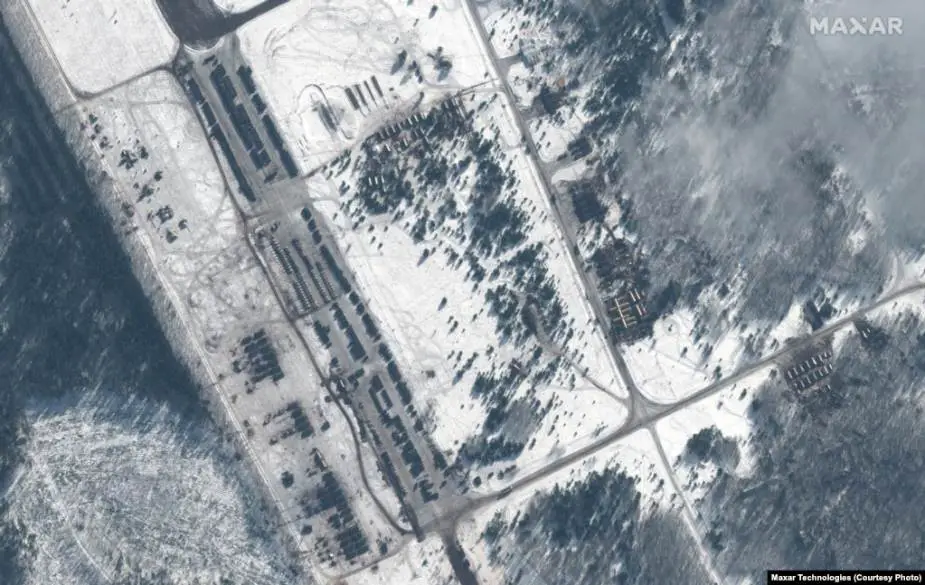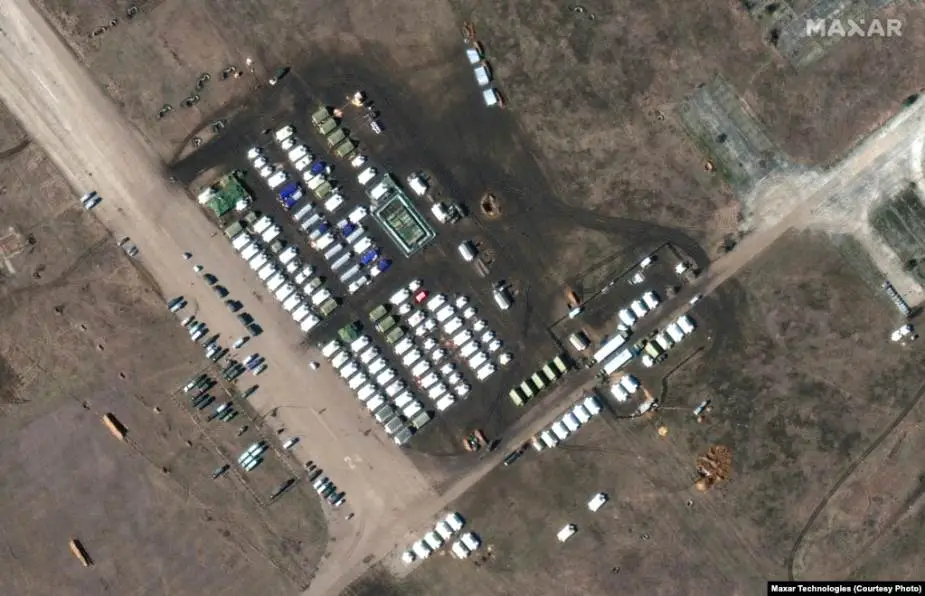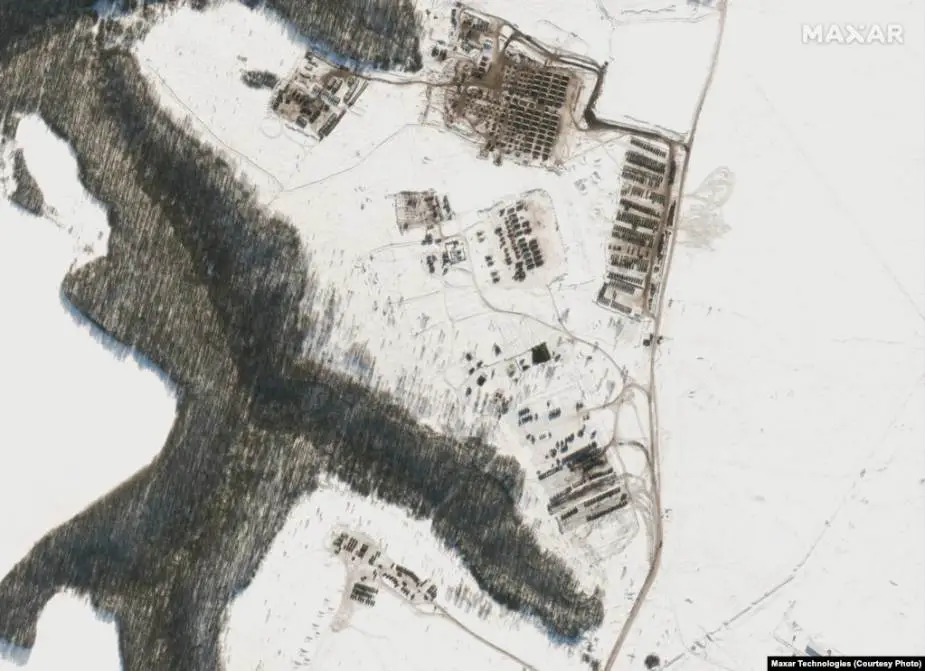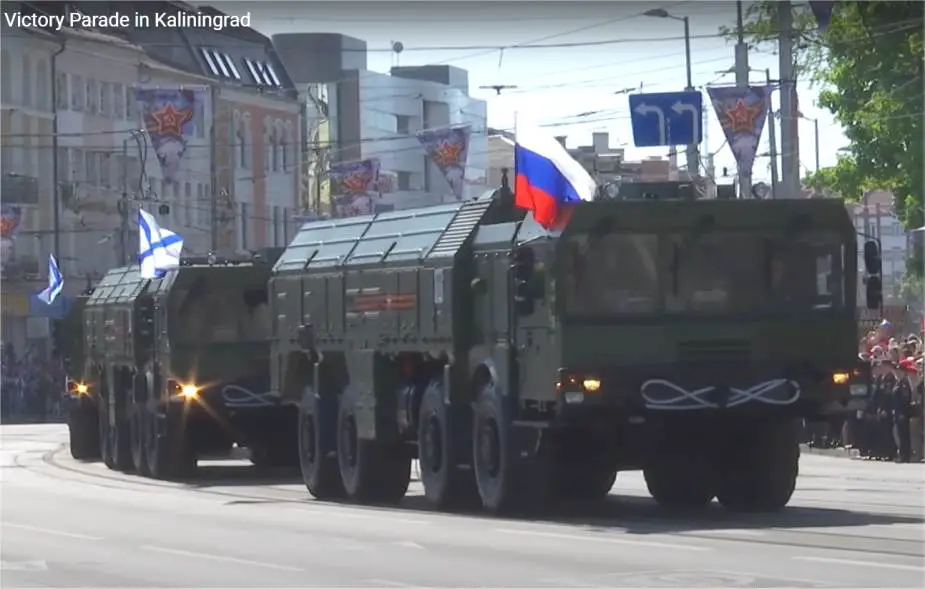According to a document issued by Vasyl Korotkyi, of Ukrinform, Ukrainian and American experts, as well as the Main Intelligence Directorate of the Ukrainian Defense Ministry, warned that under the pretext of holding strategic exercises in Belarus, Russia may resort to a large-scale offensive against Ukraine. The Russian forces deployed at Ukraine's borders are estimated at about 120,000 soldiers - rising to 140,000 service personnel in total if the navy and air force are included. Army Recognition editorial team also has added the latest information according to Open-source published on the Internet.
Follow Army Recognition on Google News at this link

A new deployment of Russian troops, vehicles, and helicopters was identified on February 10, 2022, at the Zyabrovka airfield near Homel, Belarus, less than 25 kilometers from the border with Ukraine. (Picture source rferl.org)
A first question arises: what is the number of Russian troops ready to be involved against Ukraine? How many units of armament and military equipment do they have? In general, the answer to these questions was given at a meeting of the OSCE (Organization for Security and Co-operation in Europe) Forum for Security Co-operation on July 1, 2021. As Ukraine currently chairs this OSCE policy-making body, the issue of implementing and modernizing the 2011 Vienna Document on Confidence- and Security-Building Measures was raised on February 9, 2022. The main speaker from Ukraine was Head of the Main Directorate for International Cooperation and Verification of the Ukrainian Armed Forces, Lieutenant General Leonid Holopatiuk. In particular, he pointed to the transformation of the occupied territories of Donbas, in southeastern Ukraine, into a "gray zone" that is not covered by the OSCE regime of arms control and confidence- and security-building measures.
Another factor of destabilization is the militarization of the occupied Crimea, which President Putin claims is now part of Russia as it was before Stalin “gave” it to Ukraine. The non-transparent nature of military exercises in the Russian Armed Forces also does not inspire confidence.
Russian-backed separatist forces in Donbas are larger than some European armies
"Ukraine insists that the Russian Federation has to provide in the Global Exchange of Military Information data on the number of its troops and weapons deployed on the territory of Ukraine," Lieutenant General Leonid Holopatiuk said. He stressed the need to develop effective mechanisms of international control over the military activities of the Russian-occupying forces deployed to the temporarily occupied territory in the eastern part of Ukraine and in the Autonomous Republic of Crimea.
The Ukrainian general said that today, Russia has already created three groups of troops near the border with Ukraine, "which are capable of carrying out sudden offensive operations on the territory of Ukraine with limited objectives without declaring mobilization and with minimal preparatory measures." And this is not taking into account the Crimean peninsula turned into a "ground aircraft carrier" and the occupied areas of Donbas where Russia's deployed army corps in terms of their military power and strength outnumber the armies of a number of European countries.
The creation of a group of Russian occupation troops in the temporarily occupied territories of the Donetsk and Luhansk regions as part of the 1st and 2nd Army Corps has led to the emergence of a large number of weapons and military equipment in eastern Ukraine.
The combat composition of the Russian 1st Army Corps includes:
* 5 brigades (1st, 3rd, 5th Separate Motorized Rifle brigades, 100th Separate Motorized Rifle Brigade of the "Republican Guard" and a separate artillery brigade);
* 3 separate regiments (11th Separate Motorized Rifle Regiment, 9th Separate Assault Motorized Rifle Regiment of the Marine Corps, and a separate commandant's regiment);
* 10 separate battalions (divisions).
The combat composition of the 2nd Army Corps includes:
* 4 brigades (2nd, 4th, 7th Separate Motorized Rifle brigades and a separate artillery brigade);
* 2 regiments (6th Separate Motorized Rifle Regiment and Separate commandant's regiment);
* 6x separate battalions (divisions).
About 35,000 servicepersons serve in the 1st and 2nd Army Corps.
These army corps have 481 units of main battle tanks (MBTs), 914 units of armored combat vehicles, 720 units of artillery systems, and 202 units of multiple launch rocket systems (MLRS) in the non-government-controlled territories of Donbas.
At the same time, the command and staff posts, as well as positions of scarce specialties in the 1st (Donetsk) and 2nd (Luhansk) Army Corps, are occupied by personnel of the Armed Forces of the Russian Federation with a total number of about 650 people.
In addition, there are units of operational/combat and logistical support, military advisers, instructors of the Armed Forces of the Russian Federation in the temporarily occupied territories of the Donetsk and Luhansk regions. Their total number is 2,100 Russian servicepersons.
To maintain constant tension on the contact line and to ensure the viability of the 1st and 2nd Army Corps, the ammunition and combustive and lubricating materials are supplied from the territory of the Russian Federation through uncontrolled areas of the state border of Ukraine.

In Crimea, a new deployment of Russian troops and equipment is visible at the Oktyabrskoye airfield north of Simferopol on February 10, 2022. (Picture source rferl.org)
Crimea as a "ground aircraft carrier"
The militarization of Crimeа remains another destabilizing factor. The peninsula has become a so-called "ground aircraft carrier". Today, a powerful Russian joint task force has been created on the territory of Crimea, which includes land, air, and naval components, and has the strength of about 32,500 servicemen. In addition, Russian Coastal Defense forces and National Guard units (up to two brigades), as well as the Russian FSB Border Guard Service, have been deployed.
This indicates an active augmentation of strike capabilities of the Russian Armed Forces, which are illegally based on the territory of the peninsula, by increasing the number of troops (forces), equipping them with new models of weapons and military equipment. With six more Russian warships moving into the Black Sea, analysts point to the coming weeks as a high-risk moment when a further invasion - if one is planned - could happen.
The basis of the ground component is the 22nd Army Corps, on the basis of which it is planned to create a combined arms army, and the 810th Detached Marine Brigade. Currently, six battalion-strong tactical groups are ready for employment.
The air component has been reinforced by the deployment on the Crimean peninsula of bomber, assault, fighter and army aviation. Belbek and Gvardiyske airfields were reconstructed to accommodate Russian long-range bombers on the peninsula. The infrastructure is being prepared to allow the storage of nuclear weapons on the territory of Crimea.
The combat capabilities of the naval component have been increased by adopting the latest warships and submarines – carriers of maritime-based cruise missiles of the "Caliber" type (up to 70 warships/gunboats, six submarines, a total volley – 84 missiles).
According to data provided by Russia as part of the annual exchange of military information in accordance with the 2011 Vienna Document on Confidence- and Security-Building Measures, there has been a threefold increase in the number of the Russian Federation weapons and military equipment in the Autonomous Republic of Crimea over the past six years.
There were 684 units of weapons and military equipment on the territory of the Autonomous Republic of Crimea as of January 1, 2020, or 453 units more than on January 1, 2014. In particular, after the occupation of the peninsula, Russia transferred overthere 31 main battle tanks, about 200 armored combat vehicles, almost 100 artillery systems, as well as 63 combat aircraft, and 34 combat helicopters.

Multiple Russian battle groups and troop housing areas are visible at the Kursk training area on February 9, 2022. (Picture source rferl.org)
Three groups ready for sudden offensive
The Russian Federation continues its military build-up along the state border of Ukraine, in particular, the active creation of brand-new military units and the reorganization of existing military formations in order to enhance their combat potential. Currently, 28 battalion-strong tactical groups are deployed along the state border of Ukraine.
The creation of three new formations is complete – two Armies and an Army Corps, which became fully operational in 2021.
In the ground component deployed in the Western strategic area, the 20th Combined Arms Army consisting of the 3rd Motorized division and the 144th motorized division has been created. The 448th Missile Brigade of the 20th Army is equipped with mobile short-range ballistic missile systems Iskander (or Iskander-M).
In the South-Western strategic area, the 8th Combined Arms Army consisting of the 150th Motorized Division, the 20th Separate Motorized Rifle Brigade, as well as operationally subordinated 1st and 2nd Army Corps, have been created. The Iskander missile brigades are being established (if not yet already established) within the military district and the Army.
In general (before the recent considerable reinforcement for “military exercises” in Russia and Belarus), the strength of the land task force of the Russian Armed Forces along the border of Ukraine amounts to about 87,000 military personnel, up to 1,100 tanks; up to 2,600 armored fighting vehicles; up to 1,100 artillery systems; up to 360 MLRS, 18 mobile short-range ballistic missile systems.
The air component continues to be re-equipped with modern and upgraded models of aircraft (Su-30SM, Su-35S, Su-34, Su-25SM3, MiG-31K with a hypersonic Kinzhal system, as well as helicopters of various modifications). In total, about 330 combat aircraft and 230 helicopters are deployed at base airfields near the Ukrainian state border.
The formation of mobilization deployment support centers continues, which can allow for the establishment of up to four combined arms divisions (Boguchar, Kamensk-Shakhtinsky, Novoozerne/temporary occupied territory of the Autonomous Republic of Crimea).

Russian Iskander-M mobile ballistic missile systems are deployed in Kalinigrad (Russian moD)
Any role for the Kalinigrad enclave?
Kaliningrad is registered as the Kaliningrad Special Defence District (KOR). As a major transport hub, with sea and river ports, the city is home to the headquarters of the Baltic Fleet of the Russian Navy, and is one of the largest industrial centers in Russia. While in the 1990s many Soviet-era city names commemorating Communist leaders were changed (e.g. Leningrad reverting to Saint Petersburg), Kaliningrad remains named as it was. Since the early 1990s, the Kaliningrad oblast has been a Free Economic Zone (FEZ Yantar). In 2005 the city marked 750 years of existence as Königsberg/Kaliningrad. In July 2007, Russian First Deputy Prime Minister Sergei Ivanov declared that if US-controlled missile defense systems were deployed in Poland, then nuclear weapons might be deployed in Kaliningrad. On November 5, 2008, Russian leader Dmitry Medvedev said that installing missiles in Kaliningrad was almost a certainty. These plans were suspended, however, in January 2009. But during late 2011, a long-range Voronezh radar was commissioned to monitor missile launches within about 6,000 kilometers (3,728 miles). It is situated in the settlement of Pionersky (formerly German Neukuhren) in Kaliningrad Oblast. On 21 November 2016, Viktor Ozerov, the head of the defense committee of the Federation Council, the upper house of Russia's parliament, said Iskander ballistic missiles and S-400 air defense missiles would be deployed in Kaliningrad, which is Russia's westernmost territory.
A pure assumption, the Russian enclave of Kaliningrad might serve as a logistical platform but, precisely, as it is surrounded by two NATO countries – Poland in the south, and Lithuania in the North –, it would be hazardous, if not risky, to use it in the framework of an offensive against Ukraine, even though it is heavily defended, namely with Iskander-M and S-400 missiles.














